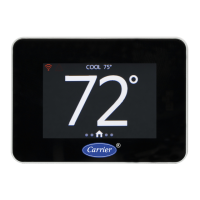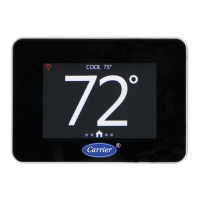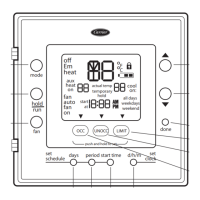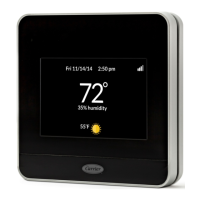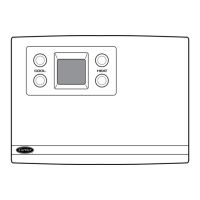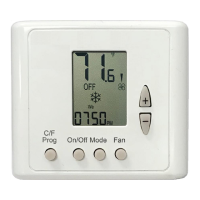Appendix E: BACnet Object Notes
Carrier Connect™ Wi-Fi Thermostat 33CONNECTSTAT43FX CARRIER CORPORATION ©2021
Installation Guide All rights reserved
61
Gated Installer Configuration
After the installer enables BACnet in the installer menu, they will have the opportunity to also select BACNET
CONFIG WRITE. Enabling BACNET CONFIG WRITE allows the installer to write to all the installer configuration
BACnet Objects (AV5XX, BV5XX and MSVXX) remotely over the BACnet network. When the installer has completed
configuring the device, they may write Inactive to CFG_WR_EN (BV511) to disable writes to installer configuration
objects.
NOTE Re-enabling BACNET CONFIG WRITE must be done from the installer menu at the thermostat.
Multiplexed Inputs
Each analog input has a corresponding multiplexer that is used to select between the measured input value (AI1
in the figure below) and a network object value (AV1 in the figure below). The output of the multiplexer (AV2 in the
figure below) is used in the equipment control algorithms. When the gate object (BV1 in the figure below) is active
the network object’s value is passed on to the output of the multiplexer, when the gate object is inactive the
measured input value is passed on to the output of the multiplexer. The gate object value is a configuration object
and is backed up to non-volatile memory. If the network object’s value has not been written to within 5 minutes,
the output of the multiplexer defaults to the measured input value.
Network Controlled Outputs
The thermostat has 3 outputs (Y3, W2, and OB) that can be assigned to optional equipment when the default
assignment is not required for the equipment configuration. When any of these 3 outputs are left unassigned, they
can be configured to be network controlled outputs by changing their mode from DISABLED/OFF to
ENERGIZED_ACTIVE or ENERGIZED_INACTIVE in the installer menu or through the network configuration objects.
There are 3 BV objects that control whether an output is active or inactive. These objects must be repeatedly
written to over the network within the time configured in the GP_OUT_TIMEOUT (MSV508) configuration object or
the output goes to the configured inactive state. The following truth table describes the action of the physical
outputs as they relate to the controlling object, Mode Object, and the timeout status.
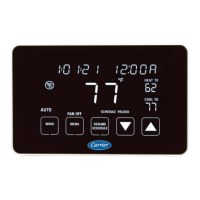
